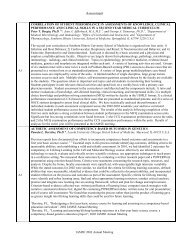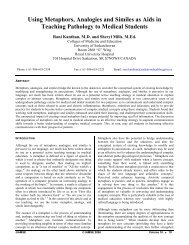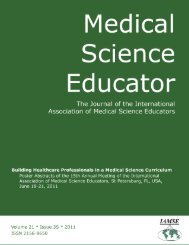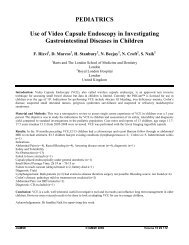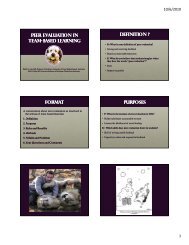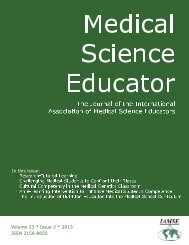Click here to view complete journal in pdf-format - IAMSE
Click here to view complete journal in pdf-format - IAMSE
Click here to view complete journal in pdf-format - IAMSE
Create successful ePaper yourself
Turn your PDF publications into a flip-book with our unique Google optimized e-Paper software.
scores were subject <strong>to</strong> Fisher's exact test (N=910<br />
students from 9 years). Groups were def<strong>in</strong>ed as<br />
pass<strong>in</strong>g or fail<strong>in</strong>g IRATs and pass<strong>in</strong>g or fail<strong>in</strong>g one<br />
or more course exams (70% pass/fail cu<strong>to</strong>ff).<br />
RESULTS<br />
Overall, 30.0% of students failed at least one exam.<br />
Students who failed the <strong>in</strong>itial IRATs had a<br />
significantly higher exam failure rate. As a<br />
diagnostic test, the IRATs had a positive predictive<br />
value of 0.754, a negative predictive value of 0.770,<br />
a likelihood ratio (LR) of 7.16 for fail<strong>in</strong>g at least one<br />
exam (i.e., students fail<strong>in</strong>g IRATs are 7 times more<br />
likely <strong>to</strong> fail an exam) and a LR of 6.04 for fail<strong>in</strong>g<br />
the course. Scores from only the first one or two<br />
IRATs had a much lower predictive value. Female<br />
students had lower performance on both IRATs and<br />
exams. Their IRAT performance was also less<br />
predictive of exam performance (LR=5.19 for<br />
females v. 11.82 for males). This may be due <strong>to</strong> a<br />
significant trend of females <strong>to</strong> perform more poorly<br />
<strong>in</strong> the first two IRATs than <strong>in</strong> subsequent IRATs and<br />
exams. The predictive value of IRATs was much<br />
higher than that of entry credentials such as MCAT<br />
scores.<br />
CONCLUSIONS<br />
In addition <strong>to</strong> its role <strong>in</strong> TBL per se, IRATs may be<br />
useful <strong>in</strong> identify<strong>in</strong>g at risk students prior <strong>to</strong> high<br />
stakes exams. Formal <strong>in</strong>tervention, or at least<br />
<strong>in</strong>form<strong>in</strong>g students of their risk, may help them<br />
remedy early academic problems.<br />
TBL/PBL Abstract ID: 227<br />
BASIC, CLINICAL & SOCIAL SCIENCES<br />
COME ALIVE THROUGH A “LIVING THE<br />
DIABETIC LIFE” MODIFIED TBL<br />
Sally Tw<strong>in</strong><strong>in</strong>g, PhD, Nancy Havas, MD, Kelly<br />
Hagedorn, BA, Er<strong>in</strong> Preloger, BA, Car<strong>in</strong>a<br />
Jackman, BA, Shannon Baumer, BS, Kimberly<br />
G<strong>in</strong>sbach, BA, Medical College of Wiscons<strong>in</strong>,<br />
Milwaukee, WI, USA<br />
PURPOSE<br />
Chronic disease care requires understand<strong>in</strong>g of<br />
basic science pr<strong>in</strong>ciples and social science pr<strong>in</strong>ciples<br />
along with empathy and compassion. Team-based<br />
Learn<strong>in</strong>g (TBL) <strong>in</strong>volves application of scientific<br />
knowledge <strong>in</strong> a cl<strong>in</strong>ical context but traditionally<br />
does not actively target student’s affective learn<strong>in</strong>g.<br />
To address this gap, we designed and implemented<br />
a “liv<strong>in</strong>g the diabetic life” modified TBL.<br />
METHODS<br />
Twenty-eight M1 students <strong>complete</strong>d a basic science<br />
pr<strong>in</strong>ciple pre-test. Consistent with TB, 4 days <strong>in</strong><br />
advance, students received prepara<strong>to</strong>ry materials:<br />
read<strong>in</strong>gs, 1 of 5 “live the diabetic life” scenarios (e.g.<br />
diabetic with low economic status), diabetic glucose<br />
moni<strong>to</strong>r<strong>in</strong>g equipment and required activities. In<br />
class activities began with a pre-meal glucose<br />
measurement and one of three assigned meals.<br />
Students measured glucose levels 4x follow<strong>in</strong>g<br />
lunch. Teams were formed based on diabetic<br />
scenario. The application exercise was <strong>to</strong> prepare<br />
and deliver a presentation outl<strong>in</strong><strong>in</strong>g the diabetic<br />
scenario, patient compliance issues, challenges<br />
associated with “liv<strong>in</strong>g the life”, implications for<br />
care and impact of diet on glucose levels us<strong>in</strong>g<br />
scientific pr<strong>in</strong>ciples. Students <strong>complete</strong>d a post-test<br />
and a qualitative survey.<br />
RESULTS<br />
Students scored an average of 4.1 po<strong>in</strong>ts out of 17<br />
higher on the post-test relative <strong>to</strong> the pre-test.<br />
Student presentations demonstrated achieved<br />
science and affective objectives. Overall, students<br />
highly rated the session (Mean =3.5 Scale 1 poor, 4<br />
excellent). Typical comments emphasized the<br />
struggle <strong>to</strong> comply with a diabetic regimen and<br />
importance of the ga<strong>in</strong>ed “liv<strong>in</strong>g” profile of diabetes.<br />
CONCLUSIONS<br />
When a student assumes the role of a chronic<br />
disease patient, the sciences become lived<br />
experiences which translate <strong>to</strong> patient care and<br />
compassion.<br />
TBL/PBL Abstract ID: 228<br />
ADAPTIVE EXPERTISE IN PBL: CREATING<br />
THE NEXT CHALLENGE<br />
Adam Miller 1 , Lamia Ibrahim MD 2,3 , Kather<strong>in</strong>e<br />
Kelly MD 2 , Dan Wolpaw MD 1,3 1 Case Western<br />
Reserve University, Cleveland, OH; 2 University<br />
Hospitals Case Medical Center, Cleveland, OH;<br />
3 Veterans Affairs Medical Center, Louis S<strong>to</strong>kes,<br />
Cleveland, OH, USA<br />
PURPOSE<br />
Literature suggests adaptive expertise can be<br />
cultivated through progressive problem solv<strong>in</strong>g<br />
challenges. We sought <strong>to</strong> determ<strong>in</strong>e whether we<br />
could identify and cultivate adaptive expertise by<br />
challeng<strong>in</strong>g students <strong>to</strong> apply new pieces of cl<strong>in</strong>ical<br />
data <strong>to</strong> established PBL cases.<br />
METHODS<br />
Our <strong>in</strong>stitution uses a small group case-based PBL<br />
precl<strong>in</strong>ical curriculum. At the conclusion of one of<br />
these cases, we <strong>in</strong>troduced new cl<strong>in</strong>ical data <strong>to</strong><br />
create a novel challenge. We piloted this approach<br />
with two groups of volunteer first year medical<br />
Medical Science Educa<strong>to</strong>r © <strong>IAMSE</strong> 2012 Volume 22(4S) 327



